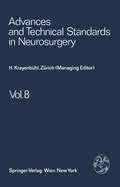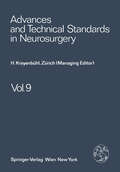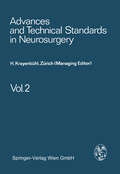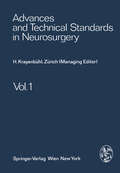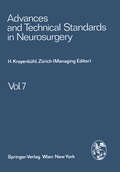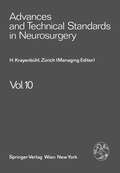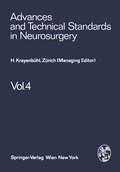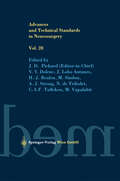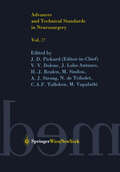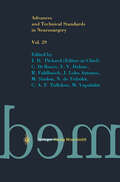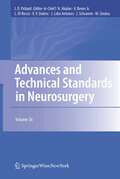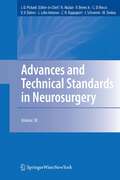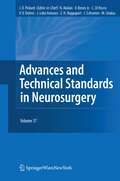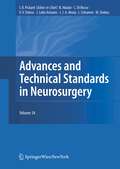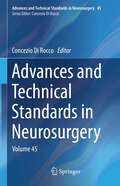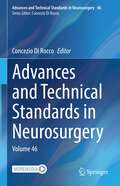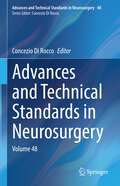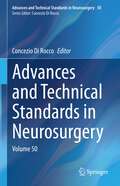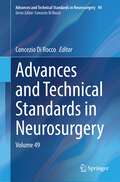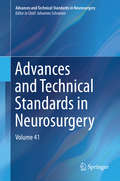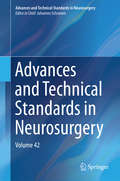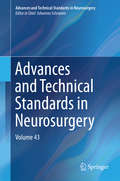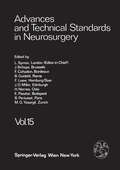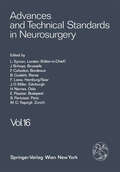- Table View
- List View
Advances and Technical Standards in Neurosurgery (Advances and Technical Standards in Neurosurgery #8)
by H. Krayenbühl J. Brihaye F. Loew V. Logue S. Mingrino B. Pertuiset L. Symon H. Troupp M. G. Ya?argilAs an addition to the European postgraduate training system for young neurosurgeons we began to publish in 1974 this series devoted to Advances and Technical Standards in Neurosurgery which was later sponsored by the Euro pean Association of Neurosurgical Societies. The fact that the English language is well on the way to becoming the international medium at European scientific conferences is a great asset in terms of mutual understanding. Therefore we have decided to publish all contributions in English, regardless of the native language of the authors. All contributions are submitted to the entire editorial board before publication of any volume. Our series is not intended to compete with the publications of original scientific papers in other neurosurgical journals. Our intention is, rather, to present fields of neurosurgery and related areas in which important recent advances have been made. The contributions are written by specialists in the given fields and constitute the first part of each volume. In the second part of each volume, we publish detailed descriptions of standard operative procedures, furnished by experienced clinicians; in these articles the authors describe the techniques they employ and explain the advantages, difficulties and risks involved in the various procedures. This part is intended primarily to assist young neurosurgeons in their postgraduate training. However, we are convinced that it will also be useful to experienced, fully trained neurosurgeons.
Advances and Technical Standards in Neurosurgery: Volume 9 (Advances and Technical Standards in Neurosurgery #9)
by H. Krayenbühl J. Brihaye F. Loew V. Logue S. Mingrino B. Pertuiset L. Symon H. Troupp M. G. Ya?argilAs an addition to the European postgraduate training system for young neurosurgeons we began to publish in 1974 this series devoted to Advances and Technical Standards in Neurosurgery which was later sponsored by the Euro pean Association of Neurosurgical Societies. The fact that the English language is well on the way to becoming the international medium at European scientific conferences is a great asset in terms of mutual understanding. Therefore we have decided to publish all contributions in English, regardless of the native language of the authors. All contributions are submitted to the entire editorial board before publication of any volume. Our series is not intended to compete with the publications of original scientific papers in other neurosurgical journals. Our intention is, rather, to present fields of neurosurgery and related areas in which important recent advances have been made. The contributions are written by specialists in the given fields and constitute the first part of each volume. In the second part of each volume, we publish detailed descriptions of standard operative procedures, furnished by experienced clinicians; in these articles the authors describe the techniques they employ and explain the advantages, difficulties and risks involved in the various procedures. This part is intended primarily to assist young neurosurgeons in their postgraduate training. However, we are convinced that it will also be useful to experienced, fully trained neurosurgeons.
Advances and Technical Standards in Neurosurgery (Advances and Technical Standards in Neurosurgery #2)
by H. Krayenbühl J. Brihaye F. Loew V. Logue S. Mingrino B. Pertuiset L. Symon H. Troupp M. G. Ya?argilThere are two important reasons for commencing this new series of publi cations entitled "Advances and Technical Standards in Neurosurgery": 1. the lack of any organized common European postgraduate training system for young neurosurgeons and 2. the language barriers, which impede the exchange of neuro surgical findings in Europe more than in other parts of the world. The fact that the English language is well on the way to becoming the international medium at European scientific conferences is a great asset in terms of mutual understanding. Therefore the Editors have decided to publish all contributions in English, regardless of the native language of the authors. All contributions are submitted to the entire editorial board before publi cation of any volume. Our series is not intended to compete with the publications of original scientific papers in other neurosurgical journals. Our intention is, rather, to present fields of neurosurgery and related areas in which important recent advances have been made. The contributions will be written by specialists in the given fields and will constitute the first part of each volume.
Advances and Technical Standards in Neurosurgery (Advances and Technical Standards in Neurosurgery #6)
by H. Krayenbühl J. Brihaye F. Loew V. Logue S. Mingrino B. Pertuiset L. Symon H. Troupp M. G. Ya?argilAs an addition to the European postgraduate training system for young neurosurgeons we began to publish in 1974 this·series devoted to Advances and Technical Standards in Neurosurgery which was later sponsored by the European Association of Neurosurgical Societies. The fact that the English language is well on the way to becoming the international medium at European scientific conferences is a great asset in terms of mutual understanding. Therefore we have decided to publish all contributions in English, regardless of the native language of the authors. All contributions are submitted to the entire editorial board before publication of any volume. Our series is not intended to compete with the publications of original scientific papers in other neurosurgical journals. Our intention is, rather, to present fields of neurosurgery and related areas in which important recent advances have been made. The contributions are written by specialists in the given fields and constitute the first part of each volume. In the second part of each volume, we publish detailed descriptions of standard operative procedures, furnished by experienced clinicians; in these articles the authors describe the techniques they employ and explain the advantages, difficulties and risks involved in the various procedures. This part is intended primarily to assist young neurosurgeons in their postgraduate training. However, we are convinced that it will also be useful to experienced, fully trained neurosurgeons.
Advances and Technical Standards in Neurosurgery (Advances and Technical Standards in Neurosurgery #1)
by H. Krayenbühl J. Brihaye F. Loew V. Logue S. Mingrino B. Pertuiset L. Symon H. Troupp M. G. Ya?argilThere are two important reasons for commencing this new series of publi cations entitled "Advances and Technical Standards in Neurosurgery": 1. the lack of any organized common European postgraduate training system for young neurosurgeons and 2. the language barriers, which impede the exchange of neuro surgical findings in Europe more than in other parts of the world. The fact that the English language is well on the way to becoming the international medium at European scientific conferences is a great asset in terms of mutual understanding. Therefore the Editors have decided to publish all contributions in English, regardless of the native language of the authors. All contributions are submitted to the entire editorial board before publi cation of any volume. Our series is not intended to compete with the publications of original scientific papers in other neurosurgical journals. Our intention is, rather, to present fields of neurosurgery and related areas in which important recent advances have been made. The contributions will be written by specialists in the given fields and will constitute the first part of each volume.
Advances and Technical Standards in Neurosurgery (Advances and Technical Standards in Neurosurgery #7)
by H. Krayenbühl J. Brihaye F. Loew V. Logue S. Mingrino B. Pertuiset L. Symon H. Troupp M. G. YasargilAs an addition to the European postgraduate training system for young neurosurgeons we began to publish in 1974 this series devoted to Advances and Technical Standards in Neurosurgery which was later sponsored by the Euro pean Association of Neurosurgical Societies. The fact that the English language is well on the way to becoming the international medium at European scientific conferences is a great asset in terms of mutual understanding. Therefore we have decided to publish all contributions in English, regardless of the native language of the authors. All contributions are submitted to the entire editorial board before publication of any volume. Our series is not intended to compete with the publications of original scientific papers in other neurosurgical journals. Our intention is, rather, to present fields of neurosurgery and related areas in which important recent advances have been made. The contributions are written by specialists in the given fields and constitute the first part of each volume. In the second part of each volume, we publish detailed descriptions of standard operative procedures, furnished by experienced clinicians; in these articles the authors describe the techniques they employ and explain the advantages, difficulties and risks involved in the various procedures. This part is intended primarily to assist young neurosurgeons in their postgraduate training. However, we are convinced that it will also be useful to experienced, fully trained neurosurgeons.
Advances and Technical Standards in Neurosurgery (Advances and Technical Standards in Neurosurgery #10)
by H. Krayenbühl J. Brihaye F. Loew S. Mingrino B. Pertuiset L. Symon H. Troupp M. G. Ya?argilAs an addition to the European postgraduate training system for young neurosurgeons we began to publish in 1974 this series devoted to Advances and Technical Standards in Neurosurgery which was later sponsored by the European Association of Neurosurgical Societies. The fact that the English language is well on the way to becoming the international medium at European scientific conferences is a great asset in terms of mutual understanding. Therefore we have decided to publish all contributions in English, regardless of the native language of the authors. All contributions are submitted to the entire editorial board before publication of any volume. Our series is not intended to compete with the puhlicationR of original scientific papers in other neurosurgical journals. Our intention is, rather, to present fields of neurosurgery and related areas in which important recent advances have been made. The contributions are written by specialists in the given fields and constitute the first part of each volume. In the second part of each volume, we publish detailed descriptions of standard operative procedures, furnished by experienced clinicians; in these articles the authors describe the techniques they employ and explain the advantages, difficulties and risks involved in the various procedures. This part is intended primarily to assist young neurosurgeons in their postgraduate training. However, we are convinced that it will also be useful to experienced, fully trained neurosurgeons.
Advances and Technical Standards in Neurosurgery (Advances and Technical Standards in Neurosurgery #4)
by S. Mingrino B. Pertuiset L. Symon H. Troupp M. G. Ya?argil H. Krayenbühl F. Loew V. Logue J. BrihayeThere are two important reasons for publishing this new series entitled "Advances and Technical Standards in Neurosurgery": 1. the lack of anyor ganized common European postgraduate training system for young neurosurgeons and 2. the language barriers, which impede the exchange of neurosurgical findings in Europe more than in other parts of the world. The fact that the English language is well on the way to becoming the international medium at European scientific conferences is a great asset in terms of mutual understanding. Therefore the Editors have decided to publish all contributions in English, regardless of the native language of the authors. All contributions are submitted to the entire editorial board before publi cation of any volume. Our series is not intended to compete with the publications of original scientific papers in other neurosurgical journals. Our intention is, rather, to present fields of neurosurgery and related areas in which important recent advances have been made. The contributions are written by specialists in the given fields and constitute the first part of each volume. In the second part of each volume, we publish detailed descriptions of standard operative procedures, furnished by experienced clinicians; in these articles the authors describe the techniques they employ and explain the advantages, difficulties and risks involved in the various procedures. This part is intended primarily to assist young neurosurgeons in their postgraduate train ing. However, we are convinced that it will also be useful to experienced, fully trained neurosurgeons.
Advances and Technical Standards in Neurosurgery (Advances and Technical Standards in Neurosurgery #28)
by J. D. PickardAs an addition to the European postgraduate training system for young neurosurgeons, we began to publish in 1974 this series of Advances and Technical Standards in Neurosurgery which was later sponsored by the European Association of Neurosurgical Societies. This series was first discussed in 1972 at a combined meeting of the Italian and German Neurosurgical Societies in Taormina, the founding fathers of the series being Jean Brihaye, Bernard Pertuiset, Fritz Loew and Hugo Krayenbuhl. Thus were established the principles of European co operation which have been born from the European spirit, flourished in the European Association, and have been associated throughout with this senes. The fact that the English language is now the international medium for communication at European scientificconferences is a great asset in terms of mutual understanding. Therefore we have decided to publish all contri butions in English, regardless of the native language of the authors. All contributions are submitted to the entire editorial board before publication of any volume for scrutiny and suggestions for revision. Our series is not intended to compete with the publications of original scientificpapers in other neurosurgical journals. Our intention is, rather, to present fields of neurosurgery and related areas in which important recent advances have been made. The contributions are written by specialists in the given fieldsand constitute the first part of each volume.
Advances and Technical Standards in Neurosurgery (Advances and Technical Standards in Neurosurgery #27)
by J. D. Pickard V. V. Dolenc J. Lobo Antunes H.-J. Reulen M. Sindou A. J. Strong N. de Tribolet C. A. Tulleken M. VapalahtiAs an addition to the European postgraduate training system for young neurosurgeons, we began to publish in 1974 this series of Advances and Technical Standards in Neurosurgery which was later sponsored by the European Association of Neurosurgical Societies. This series was first discussed in 1972 at a combined meeting of the Italian and German Neurosurgical Societies in Taormina, the founding fathers of the series being Jean Brihaye, Bernard Pertuiset, Fritz Loew and Hugo Krayenbuhl. Thus were established the principles of European co operation which have been born from the European spirit, flourished in the European Association, and have been associated throughout with this senes. The fact that the English language is now the international medium for communication at European scientific conferences is a great asset in terms of mutual understanding. Therefore we have decided to publish all contri butions in English, regardless of the native language of the authors. All contributions are submitted to the entire editorial board before publication of any volume for scrutiny and suggestions for revision. Our series is not intended to compete with the publications of original scientific papers in other neurosurgical journals. Our intention is, rather, to present fields of neurosurgery and related areas in which important recent advances have been made. The contributions are written by specialists in the given fields and constitute the first part of each volume.
Advances and Technical Standards in Neurosurgery (Advances and Technical Standards in Neurosurgery #29)
by J. D. Pickard C. Di Rocco V. V. Dolenc R. Fahlbusch J. Lobo Antunes M. Sindou N. de Tribolet C. A. Tulleken M. VapalahtiAdvances and Technical Standards in Neurosurgery: Volume 36 (Advances and Technical Standards in Neurosurgery #36)
by John D. Pickard Nejat Akalan Vladimir Benes Concezio Di Rocco Vinko V. Dolenc J. Lobo Antunes Johannes Schramm Marc SindouDetecting residual cognitive function in disorders of consciousness (M. R. COLEMAN, J. D. PICKARD).- Rationale for hypothalamus-deep brain stimulation in food intake disorders and obesity (N. TORRES, S. CHABARDEES, A. L. BENABID).- Gustatory and reward brain circuits in the control of food intake (A. J. OLIVEIRA-MAIA, C. D. ROBERTS, S. A. SIMON, M. A. L. NICOLELIS).- SEEG-guided RF-thermocoagulation of epileptic foci: A therapeutic alternative for drug-resistant non-operable partial epilepsies (M. GUÉNOT, J. ISNARD, H. CATENOIX, F. MAUGUIERE, M. SINDOU).- Child abuse – some aspects for neurosurgeons (B. MADEA, M. NOEKER, I. FRANKE.- Prophylactic antibiotics and anticonvulsants in neurosurgery (B. RATILAL, C. SAMPAIO).- The dural sheath of the optic nerve: descriptive anatomy and surgical applications (P. FRANCOIS, E. LESCANNE, S. VELUT) -Surgical indications and techniques for failed coiled aneurysms (C. RAFTOPOULOS; with the collaboration of G. VAZ).
Advances and Technical Standards in Neurosurgery (Advances and Technical Standards in Neurosurgery #38)
by John D. Pickard Nejat Akalan Vladimír Benes Concezio Di Rocco Vinko V. Dolenc J. Lobo Antunes Johannes Schramm Marc Sindou Z. Harry RappaportAdvances: H. Duffau: Subpial dissection and subcortical mapping with vasculature and white matter pathways preservation in surgery for brain (low grade) gliomas. - F. Scholtes, G. Brook, D. Martin: Spinal cord injury and its treatment: current management and experimental perspectives. - M. Sindou, M. Messerer, J. Alvernia, G. Saint-Pierre: Percutaneous Biopsy through the Foramen Ovale for Parasellar lesions: Surgical anatomy, Method and Indications. - Technical Standards: C. Raftopoulos, F. Waterkeyn, E. Fomekong, T. Duprez: Percutaneous pedicle screw implantation with robotic intraoperative 2D/3D fluoroscopy for refractory low back pain. – I. Zemmoura, S. Velut, P. Francois:The choroidal fissure: anatomy and surgical implications. – I. Timofeev, T. Santarius, A.G. Kolias, P.J.A. Hutchinson: Decompressive craniectomy – operative technique and perioperative care. - S Fauser, J Zentner: Management of complex cortical dysplasia in epilepsy
Advances and Technical Standards in Neurosurgery (Advances and Technical Standards in Neurosurgery #37)
by John D. Pickard Nejat Akalan Vladimir Benes Concezio Di Rocco Vinko V. Dolenc J. Lobo Antunes Johannes Schramm Marc Sindou Z. Harry RappaportAdvancesJ. Maarrawi, P. Mertens, R. Peyron, L. Garcia-Larrea, M. Sindou: Functional exploration for neuropathic pain. - Z. H. Rappaport: The neuroscientific foundations of free will. - A. Hejcl, P. Jendelova, E. Sykova: Experimental reconstruction of the injured spinal cord. - M. Visocchi: Advances in video-assisted anterior surgical approach to the craniovertebral junction. Technical StandardsN. Akalan: Myelomeningocele (Open spina bifida): Surgical management. - M. Stoffel, C. Stüer, F. Ringel, B. Meyer: Treatment of infections of the spine. - I. Massimi, F. Novegno, C. di Rocco: Chiari Type 1 malformation in children.
Advances and Technical Standards in Neurosurgery: Volume 34 (Advances and Technical Standards in Neurosurgery #34)
by John D. Pickard Nejat Akalan Concezio Di Rocco Vinko V. Dolenc J. Lobo Antunes J. J. A. Mooij Johannes Schramm Marc SindouAdvances and Technical Standards in Neurosurgery: Volume 45 (Advances and Technical Standards in Neurosurgery #45)
by Concezio Di RoccoThis book offers an update on several basic and clinical problems in neurosurgery compiled by internationally recognized experts. This multi-thematic volume will touch on a variety of topics: from the role of women neurosurgeons in the last hundred year of the specialty history, to the pathogenesis of spinal dysraphism, to the convection-enhanced delivery of intracerebral antineoplastic drugs in children, through a review of methods and applications. The intraoperative cerebral blood flow monitoring in neurosurgery will be also discussed, offering again a comprehensive review of contemporary technologies and emerging perspectives. As for the technical standards, the book will describe the multimodality approach to cerebral gliomas, the management of thalamic tumors, the intracavitary treatment of craniopharyngiomas, the long term results of spasticity treatments, the surgical treatment of spinal vascular malformations, the management of idiopathic and refractory syringomyelia, offering at the same time an update of peripheral nerve surgery. All the chapters have to be considered an advance in the relative fields, in cerebral pathophysiology and in clinical management. Approaching the issue of technical standards in the everyday clinical practice of neurosurgery, this book is of great interest for neurosurgeons, neurologists and orthopaedists.
Advances and Technical Standards in Neurosurgery: Volume 46 (Advances and Technical Standards in Neurosurgery #46)
by Concezio Di RoccoThe book provides an update of several pathological conditions of the CNS that require neurosurgical treatment.The different chapters, written by the most eminent international scientists and clinicians in the field of neuroscience, offer a critical assessment of the relevant nosographic entities that are the subject of current scientific debate.The first chapter critically analyses the new WHO classification of brain tumours, while the second chapter is specifically devoted to intracranial tumours in the first years of life. The technical aspects of neuro-oncological surgery are addressed by two chapters dealing with the suprasellar approach to infratentorial tumours and how to decrease the risk of a specific complication of the surgical management of these tumours in the paediatric population, namely post-operative speech impairment. Hypothalamic tumours with their associated epilepsy and intracranial schwannomas complete the technical surgical section on intracranial tumours. An interesting chapter presents the latest advances in clinical prediction in neurosurgery.Spinal problems are discussed in two chapters, the first considering evolving concepts on craniovertebral and spinal instability and the second Chiari malformations.The management of intracranial arachnoid cysts is still a matter of controversy, as demonstrated in a specific chapter of the book. Another chapter deals with subdural haematomas in both adults and children.Hydrocephalus is treated in two chapters devoted to two post-inflammatory or post-infectious complications leading to specific and difficult-to-treat abnormalities in the CSF circulation.The final chapter of the book illustrates the rationale behind midface advancement in craniosynostosis.As with the previous volume in the series, the present volume represents an important contribution to the advancement of neurosurgical specialties.
Advances and Technical Standards in Neurosurgery: Volume 48 (Advances and Technical Standards in Neurosurgery #48)
by Concezio Di RoccoThis new multithematic book in the series Advances and Technical Standards in Neurosurgery offers an update on several basic and clinical problems in neurosurgery. The main topics are cerebral tumors, epilepsy and vascular malformations. The first chapter will deal with the burden of childhood cancer across the globe, a particular relevant problem in times where economic restrictions and the increased difficulties to access cure are the direct impact of the Covid19 pandemic. A very detailed chapter will provide new guidelines for neuroimaging investigations for intracerebral pathological conditions of surgical interest in the pediatric population. The technical aspects and technological advances in the surgical management of cerebral midline tumors will be covered by several chapters focusing of the optic pathways’ tumors, third ventricle tumors, mesencephalon and pineal body tumors. An update on Chiari malformations and syringomyelia, on the surgical management of epilepsy and on cerebral aneurysms and pediatric spinal vascular malformations will be provided in the remaining contributions. All chapters contribute to an important advancement in the relevant fields, thus offering a valuable contribution to the management of difficult clinical conditions.
Advances and Technical Standards in Neurosurgery: Volume 50 (Advances and Technical Standards in Neurosurgery #50)
by Concezio Di RoccoIn this book, internationally recognised experts provide an update on some important basic and technical aspects of neurosurgery. Intracranial tumours are the main focus of the book with chapters dealing with ependymomas, a tumour that still offers difficulties of interpretation in terms of both pathological features and management modalities, intraventricular tumours, which require particular attention in the choice of treatment modalities, and tumours considered typically paediatric that may still present in adulthood although with different aspects. Technical approaches to difficult anatomical areas are discussed in three chapters, dealing with the orbit, the craniocervical junction and the brainstem, respectively. Two rather didactic chapters, dealing with the minimally invasive technique for the spine and the clipping of cerebral aneurysms, are intended to contribute to the training of young neurosurgeons by illustrating the surgical steps in detail. The contribution of ultrasound to neurosurgery is illustrated in two chapters that should arouse great interest. The so-called Chiari malformations is approached in a chapter emphasising the role of cranio-cerebral disproportion in their pathogenesis. Finally, a chapter devoted to the ethical attitude that should characterise the daily practice of the neurosurgeon completes the book.Like the previous volumes in the series, this one represents an important contribution to the advancement of neurosurgical specialities.
Advances and Technical Standards in Neurosurgery: Volume 49 (Advances and Technical Standards in Neurosurgery #49)
by Concezio Di RoccoThe book offers the update on several basic and clinical problems in neurosurgery compiled by internationally recognized experts. The main topics covered are cerebral tumors, epilepsy and vascular malformations, congenital and acquired spine anomalies.The first chapter is devoted to the genetic of the Moya-Moya disease, a cerebral vascular disease quite common in Asia that is not yet sufficiently known. The second chapter is devoted to the current application of VR/AR (virtual reality/augmented reality) to pediatric neurosurgery. The next four chapters discuss the management of spine diseases, respectively the tethered cord syndrome , the severe forms of spondylolisthesis, the role of perioperative checklists, and the long-term outcomes of myelomeningocele. Two chapters deal with the surgical aspects of the management of intraventricular tumors. Cerebral tumors, namely malignant gliomas and jugular foramen tumors are the subject of the remaining chapters.Approaching the issue of technical standards in the everyday clinical practice of neurosurgery, this book of great interest for neurosurgeons, neuroradiologists, vascular and plastic surgeons.
Advances and Technical Standards in Neurosurgery: Volume 41 (Advances and Technical Standards in Neurosurgery #41)
by Johannes SchrammThis volume of Advances and Technical Standards in Neurosurgery is devoted entirely to the spine. Like other volumes in the series, it presents important recent progress in the field and offers detailed descriptions of standard procedures to assist young neurosurgeons. Among the advances considered are approaches to spinal navigation, including intraoperative imaging based navigation, and concepts of spinal robotics. The value of sagittal balance as a parameter for the neurosurgeon is examined, and a novel surgical approach to longitudinal pathologies within the spinal canal is presented. Developments in surgery for kyphosis are also discussed, with a focus on pedicle subtraction osteotomy. The technical standards section critically reviews the latest evidence regarding cervical disc arthroplasty and pedicle-based non-fusion stabilization devices. The book concludes by discussing the treatment of craniovertebral junction instability as a result of juvenile chronic arthritis.
Advances and Technical Standards in Neurosurgery: Volume 42 (Advances and Technical Standards in Neurosurgery #42)
by Johannes SchrammThis volume of Advances and Technical Standards in Neurosurgery covers some important new developments in functional neurosurgery and endovascular therapy. In the Technical Standards section a variety of topics are considered, including optic pathway gliomas, pineal lesions, cavernous sinus meningiomas and the eternal problem of minor and repetitive head injury. Endovascular treatment of a variety of lesions is now common practice and the state of the art in endovascular treatment for acute ischemic stroke is reviewed. An appraisal of the evidence on whether there is a place for microsurgical vascular decompression for essential hypertension raises interesting questions. The volume is completed by contributions on neurosurgical treatment of cluster headaches and occipital nerve stimulation.
Advances and Technical Standards in Neurosurgery: Volume 43 (Advances and Technical Standards in Neurosurgery #43)
by Johannes SchrammThis volume reviews standard treatments for spinal dural arteriovenous fistulas, examining the anatomy of arteries and veins of the sylvian fissure, as well as microsurgical advances and the development of modern therapeutic strategies in intracranial meningiomas. The advances section presents a strategy for minimizing hearing loss after stereotactic radiosurgery for vestibular schwannomas, as well as a description of the mode of action and biology of ALA, including its interaction with tumor cells and the limits of this method. A dedicated chapter addresses the essential question of the limits (and merits) of various tractography techniques and of their importance for non-specialists, who may be tempted to use them uncritically. A further chapter examines molecular markers, which have become standard in neuropathological reports on intracranial tumors, reviewing the prognostic and predictive value of these modern molecular markers in gliomas. Additional chapters round out the coverage, offering a comprehensive overview of standard and advanced techniques.
Advances and Technical Standards in Neurosurgery (Advances and Technical Standards in Neurosurgery #15)
by L. Symon J. Brihaye F. Cohadon B. Guidetti F. Loew J. D. Miller H. Nornes E. Pásztor B. Pertuiset M. G. Ya?argilAs an addition to the European postgraduate training system for young neurosurgeons we began to publish in 1974 this series devoted to Advances and Technical Standards in Neurosurgery which was later sponsored by the European Association of Neurosurgical Societies. The fact that the English language is well on the way to becoming the international medium at European scientific conferences is a great asset in terms of mutual understanding. Therefore we have decided to publish all contributions in English, regardless of the native language of the authors. All contributions are submitted to the entire editorial board before publication of any volume. Our series is not intended to compete with the publications of original scientific papers in other neurosurgical journals. Our intention is, rather, to present fields of neurosurgery and related areas in which important recent advances have been made. The contributions are written by specialists in the given fields and constitute the first part of each volume. In the second part of each volume, we publish detailed descriptions of standard operative procedures, furnished by experienced clinicians; in these articles the authors describe the techniques they employ and explain the advantages, difficulties and risks involved in the various procedures. This part is intended primarily to assist young neurosurgeons in their post graduate training. However, we are convinced that it will also be useful to experienced, fully trained neurosurgeons.
Advances and Technical Standards in Neurosurgery (Advances and Technical Standards in Neurosurgery #16)
by L. Symon J. Brihaye F. Cohadon B. Guidetti F. Loew J. D. Miller H. Nornes E. Pásztor M. G. Ya?argil B. PertuisetAs an addition to the European postgraduate training system for young neurosurgeons we began to publish in 1974 this series devoted to Advances and Technical Standards in Neurosurgery which was later sponsored by the European Association of Neurosurgical Societies. The fact that the English language is well on the way to becoming the international medium at European scientific conferences is a great asset in terms of mutual understanding. Therefore we have decided to publish all contributions in English, regardless of the native language of the authors. All contributions are submitted to the entire editorial board before publication of any volume. Our series is not intended to compete with the publications of original scientific papers in other neurosurgical journals. Our intention is, rather, to present fields of neurosurgery and related areas in which important recent advances have been made. The contributions are written by specialists in the given fields and constitute the first part of each volume. In the second part of each volume, we publish detailed descriptions Of standard operative procedures, furnished by experienced clinicians; in these articles the authors describe the techniques they employ and explain the advantages, difficulties and risks involved in the various procedures. This part is intended primarily to assist young neurosurgeons in their post graduate training. However, we are convinced that it will also be useful to experienced, fully trained neurosurgeons.
